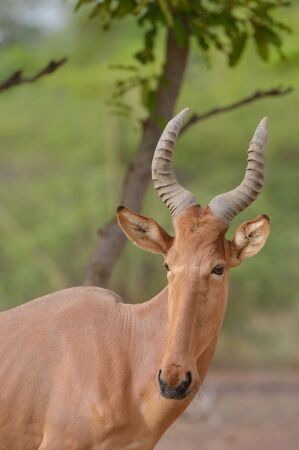

When considering hartebeest (Alcelaphus buselaphus)
hunting in Africa, hunters are indeed spoilt for choice, with not one but six subspecies of this tough African plains game trophy. The Western hartebeest (Alcelaphus buselaphus major) inhabits West Africa, from Senegal to western Chad.
Its chosen habitats include grasslands, savannas, and wooded grasslands and they normally live in herds of up to 20 members. Still, the size of these herds can grow enormously, sometimes even hitting thousands. This hartebeest can reproduce year-round, with a gestation period of around 240 days. A single calf is born, usually just before the rainy season or as the rainy season commences.
Although they are generally calm, should they be wounded or feel threatened, they can turn quite vicious. Predators of the antelope include crocodiles, lions, leopards, and hyenas, while cheetahs and jackals target the young and infirm.
The Western hartebeest is classified as endangered by the International Union for the Conservation of Nature (IUCN).
Name:
Alcelaphus buselaphus major
Male Weight:
170-350 pounds
Male Shoulder Height:
48 inches
Range:
West Africa
Life span:
11-20 years
The red hartebeest is recognized for its remarkable endurance and agility
The Western hartebeest is a large African plains game antelope and a great game hunting trophy. It has a distinctive hump on its shoulders and a sloping back. The Western Hartebeest is regarded as a tough antelope to target and sports a long neck, slender body, and long legs. Its head is elongated, as is its forehead. The antelope’s coat is reddish-brown, with a light-colored rump, whitish underbelly, and a black tail. Both sexes have lengthy, rigid, curved horns that look Z-shaped from the side, and V-shaped from the front.
When on a Western Hartebeest game hunting adventure, a good tip to remember is that these antelopes are more active in the early mornings and late afternoons, as they gather in herds to graze. These animals are active during the day, especially at dawn and dusk, gathering in herds to graze and they will sometimes graze amongst wildebeest and impala. They have excellent eyesight but a poor sense of smell and are extremely wary and vigilant. When spooked, they are known to take off in a single file run and can reach speeds of 45 miles per hour. Targeting this African plains game species requires perseverance and patience, waiting for the right moment when your shot placement is spot on. Avoid high-risk shots and aim for the vitals to ensure a swift and humane death for the hartebeest.
African hunting safaris targeting the Western hartebeest require precision shot placement and patience, waiting until the time is right to land the perfect shot. These antelopes are regarded as extremely intelligent and wary. Their eyesight is superb, making the challenge for the hunter to stalk and approach them undetected even more challenging!
Western hartebeest hunting in Africa will require a good flat shooting rifle fitted with good-quality optics. A .270 caliber shooting 130 expanding bullets is a minimum requirement when targeting this African plains game trophy. They are best hunted with .30 caliber rifles shooting a minimum of 180-grain. This combination will get the job done quickly and efficiently. The Western hartebeest remains a tough and hardy African plains game trophy that is well worth targeting when game hunting in Africa.
Search from our range of Hunts across various popular destinations in Africa.
Find A Hunt